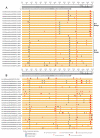Molecular Epidemiology Analysis of SARS-CoV-2 Strains Circulating in Romania during the First Months of the Pandemic
- PMID: 32823907
- PMCID: PMC7460100
- DOI: 10.3390/life10080152
Molecular Epidemiology Analysis of SARS-CoV-2 Strains Circulating in Romania during the First Months of the Pandemic
Abstract
Background: The spread of SARS-CoV-2 generated an unprecedented global public health crisis. Soon after Asia, Europe was seriously affected. Many countries, including Romania, adopted lockdown measures to limit the outbreak.
Aim: We performed a molecular epidemiology analysis of SARS-CoV-2 viral strains circulating in Romania during the first two months of the epidemic in order to detect mutation profiles and phylogenetic relatedness.
Methods: Respiratory samples were directly used for shotgun sequencing.
Results: All Romanian sequences belonged to lineage B, with a different subtype distribution between northern and southern regions (subtype B.1.5 and B.1.1). Phylogenetic analysis suggested that the Romanian epidemic started with multiple introduction events from other European countries followed by local transmission. Phylogenetic links between northern Romania and Spain, Austria, Scotland and Russia were observed, as well as between southern Romania and Switzerland, Italy, France and Turkey. One viral strain presented a previously unreported mutation in the Nsp2 gene, namely K489E. Epidemiologically-defined clusters displayed specific mutations, suggesting molecular signatures for strains coming from areas that were isolated during the lockdown.
Conclusions: Romanian epidemic was initiated by multiple introductions from European countries followed by local transmissions. Different subtype distribution between northern and southern Romania was observed after two months of the pandemic.
Keywords: Romania; SARS-CoV-2; WGS; coronavirus; mutations; outbreak; pandemic; phylogenetic analysis.
Conflict of interest statement
The authors declare no conflict of interest. The sponsor “Mereu Aproape” Foundation had no role in the design, execution, interpretation, or writing of the study.
Figures



Similar articles
-
Introduction and Characteristics of SARS-CoV-2 in North-East of Romania During the First COVID-19 Outbreak.Front Microbiol. 2021 Jul 7;12:654417. doi: 10.3389/fmicb.2021.654417. eCollection 2021. Front Microbiol. 2021. PMID: 34305826 Free PMC article.
-
SARS-CoV-2 Pandemic: A Comparison Between the Epidemiological Situation in Greece and Romania.Cureus. 2024 Feb 19;16(2):e54460. doi: 10.7759/cureus.54460. eCollection 2024 Feb. Cureus. 2024. PMID: 38510869 Free PMC article.
-
Emergence of the First Strains of SARS-CoV-2 Lineage B.1.1.7 in Romania: Genomic Analysis.JMIRx Med. 2021 Aug 13;2(3):e28049. doi: 10.2196/28049. eCollection 2021 Jul-Sep. JMIRx Med. 2021. PMID: 34424256 Free PMC article.
-
The discrepant epidemiology of Middle East respiratory syndrome coronavirus (MERS-CoV).Environ Syst Decis. 2014;34(3):383-390. doi: 10.1007/s10669-014-9506-5. Epub 2014 Jul 25. Environ Syst Decis. 2014. PMID: 32288979 Free PMC article.
-
Molecular epidemiology of HIV-1 infection in Europe: An overview.Infect Genet Evol. 2016 Dec;46:180-189. doi: 10.1016/j.meegid.2016.06.033. Epub 2016 Jun 16. Infect Genet Evol. 2016. PMID: 27321440 Review.
Cited by
-
Across regions: Are most COVID-19 deaths above or below life expectancy?Germs. 2021 Mar 15;11(1):59-65. doi: 10.18683/germs.2021.1241. eCollection 2021 Mar. Germs. 2021. PMID: 33898342 Free PMC article.
-
A Global Mutational Profile of SARS-CoV-2: A Systematic Review and Meta-Analysis of 368,316 COVID-19 Patients.Life (Basel). 2021 Nov 11;11(11):1224. doi: 10.3390/life11111224. Life (Basel). 2021. PMID: 34833100 Free PMC article. Review.
-
Biological and Clinical Significance of Adaptive Evolution of Coronaviruses.Life (Basel). 2021 Oct 23;11(11):1129. doi: 10.3390/life11111129. Life (Basel). 2021. PMID: 34833006 Free PMC article.
-
Clinical and molecular epidemiology of influenza viruses from Romanian patients hospitalized during the 2019/20 season.PLoS One. 2021 Nov 12;16(11):e0258798. doi: 10.1371/journal.pone.0258798. eCollection 2021. PLoS One. 2021. PMID: 34767579 Free PMC article.
-
Impact of Obesity-Associated SARS-CoV-2 Mutations on COVID-19 Severity and Clinical Outcomes.Viruses. 2024 Dec 30;17(1):38. doi: 10.3390/v17010038. Viruses. 2024. PMID: 39861827 Free PMC article.
References
LinkOut - more resources
Full Text Sources
Miscellaneous

